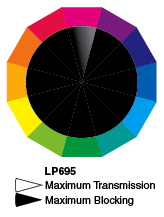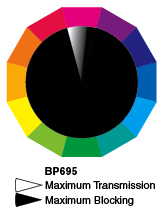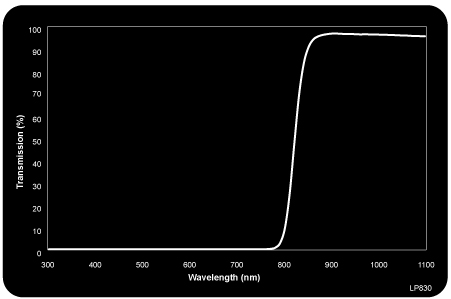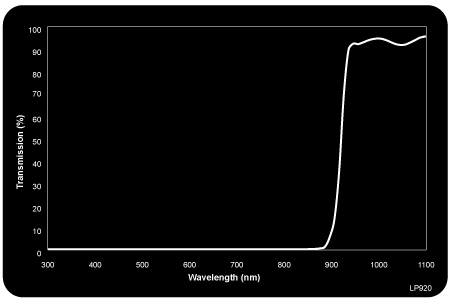|
|
Infrared Longpass - Visible Block Filters
Filters for passing select infrared wavelength ranges. Infrared pass
filters are considered mandatory for all near-infrared applications in
order to block the visible wavelengths that negate the effects of seeing
in the IR
| LP695 IR Longpass
Filter - IR LED's @ 720nm
|
Model |
Transmission |
Features |
Suitable for
|
|
LP695 |
Passes 700nm and above |
• Absorbs 690nm and below
• Lets through a small
amount of deep red light
• Almost completely blocks all
660nm red light and all shorter visible wavelengths
|
Used with monochrome cameras to aid in increased contrast
and resolution
|
|  
The single substrate LP695 Longpass Filter cuts on sharply at the
beginning of the infrared portion of the spectrum, passing the complete
near-IR spectrum out to approximately 3000nm. It lets through a
small amount of deep red light and almost completely blocks all
660nm red light and all shorter visible wavelengths.
Colour longpass filters are used with monochrome cameras to aid
in increased contrast and resolution. These filters block UV and
shorter visible wavelengths and pass longer wavelengths of light.
Except in those few cases where an IR blocking or other shortpass
filter is incorporated into the camera/sensor, for the most part
Adept will recommend the use of a broad colour bandpass filter (whose
designs incorporate these longpass filters) over colour longpass
filters alone.
This is because colour filters are usually specified for use with
similar monochromatic LED or laser diode colours in order to block
ambient light. The spectral response of most CCD/CMOS camera sensors,
typically have excellent deep red and near-infrared sensitivity.
When superimposing any longpass filter's transmittance curve over
a camera's spectral response curve, approximately half or more of
the unwanted ambient light – all of the longer wavelength
light – is not being blocked by the longpass filter. Consequently,
if it makes sense to employ a longpass filter to block some of the
ambient light, it makes even more sense to block the rest of it,
using a bandpass filter. In comparative testing where the difference
between a longpass and a bandpass filter may not seem to be dramatic,
the bandpass filter will also provide insurance for what might happen
at some point in the future. By blocking almost all of the unwanted
light, the effects of any change in ambient or introduced lighting
that often occur at a later date can be nullified. Instead
of a LP695 filter, a better alternative might be a BP735 filter.
|
| LP780 IR Longpass
Filter – IR diode lasers @ 810nm |
|
Model |
Transmission |
Features |
Suitable
for |
|
LP780 |
Passes 790nm
and above |
• Absorbs 775nm and below |
Structured laser diode modules and LED lighting that
operate in the range around 810-830nm |
|
The single substrate LP780 IR Longpass Filter is a commonly used
filter for several near-IR wavelengths found in machine vision applications.
There are both structured laser diode modules and LED lighting that
operate in the range around 810-830nm, and this filter is recommended
for these.
|
 Back
to Top Back
to Top 
| LP830
IR Longpass Filter – general IR +880nm IR LEDs |
|
Model |
Transmission |
Features |
Suitable
for |
|
LP830 |
Passes 830nm and above |
• Absorbs 815nm and below |
When LED is lighting chosen for illumination purposes |
|
An LP830 filter is recommended when LED lighting is chosen for
illumination purposes, 90% of all applications are either 880nm
or 850nm LED lighting. The LP830 filter for 880nm is also recommended
when the choice of IR lighting will be made at a later time.
A longpass filter is sufficient for most IR lighting applications.
Since ANY camera's sensitivity drops quickly beyond 880nm, there
is little or no appreciable benefit to blocking these longer wavelengths
as the camera can take care of these itself.
These single substrate filters are supplied with hard-coated
surfaces to improve transmission and inhibit staining. Staining
is a problem common to infrared filter glasses that can be found
particularly on unprotected polished surfaces which manifests
as a cloudy, white film that etches into the polished glass. Over
time, staining can greatly reduce transmission and resolution,
and cannot be simply wiped away. Factors determining the time
required and severity of staining include the year-round heat,
humidity and air quality of the surrounding area. In certain environments,
coatings are an absolute necessity.
|
 Back
to Top Back
to Top 
| LP920
IR Dichroic Longpass – IR LEDs @ 940nm |
|
Model |
Transmission |
Features |
Suitable
for |
|
LP920 |
Passes 920nm and above |
• Absorbs 690nm and below
• Reflects 690-910nm
|
• Use with infrared LEDs
• Imaging applications which employ IR vidicon or InGaAs cameras.
|
|
The single substrate, hard-coated LP920 IR Longpass filter has
been designed for use with 940nm LED illumination.
Its excellent lower wavelength blocking (10-5 blocking into the
near-IR) allows these filters to block visible emissions (particularly
the red "glow") when placed in front of multi-spectral
lighting used in semi-covert or photographic darkroom applications.
Note that the "pink" reflective surface must be mounted
facing toward the light source in these situations.
It is also a useful filter for imaging applications which employ
IR vidicon or InGaAs cameras.
|
 Back
to Top Back
to Top 
| LP1000
IR Longpass – IR Vidicon/InGaAs cameras |
|
Model |
Transmission |
Features |
Suitable
for |
|
LP1000 |
Passes1010nm and above |
• Absorbs 980nm and below
|
• IR Vidicon/InGaAs cameras
|
| The LP1000 filter cuts
on very gradually starting at 860nm, reaching its peak at 1600nm.
As such, it has few applications when used with CCD/CMOS cameras,
as it greatly attenuates the longer wavelength infrared light
that most of these cameras will respond to.
The single substrate LP1000 is more frequently used with infrared
vidicon or InGaAs cameras, where it cuts off wavelengths below
the 1550nm telecommunications band.
|
 Back
to Top Back
to Top 
| BP695
IR Longpass Filter - NIR fluorescence
|
Model |
Transmission |
Features |
Suitable
for |
|
BP695 |
Passes 670-715nm |
• Absorbs 660nm and below
• Reflects 720-1100nm
|
• Use with near-infrared LEDs
Imaging typically weak luminescence in the 680-710nm range where
the subject is often excited with 635nm or 660nm red LED lighting
• Use with laser diode illumination. |
|  
The BP695 is designed to function in the 680-715nm range such
as with 700nm LED lighting.
It is particularly useful for imaging typically weak luminescence
in the 680-710nm range where the subject is often excited with
635nm or 660nm red LED lighting.
The single substrate, hard-coated BP695 filter blocks most of
these (and lower) excitation wavelengths to remove interference
from the source. This filter is also excellent for use with laser
diode illumination.
|
 Back
to Top Back
to Top 
| BP735IR
Longpass Filter - IR LEDs @ 735nm
|
Model |
Transmission |
Features |
Suitable
for |
|
BP735 |
Passes 700-770nm |
• Absorbs 690nm and below
• Reflects 780-1065nm
|
• Use with near-infrared LEDs
• Imaging in the 700-770nm range and especially weak luminescence
in the 715-765nm range
|
|  
This filter is designed for viewing subjects in the 700-770nm
range.
It is particularly useful for imaging typically . In these situations,
the subject is often excited with 635nm or 660nm red LED lighting,
and the BP735 single substrate, hard-coated filter blocks these
(and lower) excitation wavelengths to remove interference from
the source.
This filter is also excellent for use with 720-735nm LED illumination.
|
 Back
to Top Back
to Top 
| BP800
IR Bandpass – thin filter |
|
Model |
Transmission |
Features |
Suitable
for |
|
BP800 |
Passes 730-1030nm |
• Absorbs 720nm and below, 1050nm and above |
• Use with near-infrared lighting
• Several commonly used LED and laser diode wavelengths |
|
The single substrate, hard-coated BP800 filter is a very broad
absorptive bandpass filter that cuts on sharply at 725nm (50%
point), peaks at about 800nm, and cuts off very gradually over
a range from 900 to 1200nm a cut-off range that is largely beyond
the range of sensitivity of most CCD cameras and for most machine
vision applications it is probably best to think of this as a
725nm Longpass Filter. It can be used in conjunction with several
commonly used LED and laser diode wavelengths.
Two other uses for this filters are:
a) When used with infrared vidicon or InGaAs cameras with their
sensitivities typically out to 1800nm or 2200nm, the BP800 acts
as a bandpass filter.
b) Whenever a special application arises calling for a very thin
infrared filter – thickness 1.5mm and below; e.g. for mounting
above a sensor – this is the filter of choice. The BP800
will generally not transmit visible light even when thinned to
less than 1mm.
This is an ionically coloured filter glass, whereas all other
visible blocking/infrared passing filter glasses are colloidally
coloured. Colloidally coloured IR filter glass will pass significant
amounts of visible light when made thinner.
|
 Back
to Top Back
to Top 
| BP850
IR Bandpass – high-power IR LEDs @ 850nm |
|
Model |
Transmission |
Features |
Suitable
for |
|
BP850 |
Passes IR 810-990nm |
• Absorbs 200-800nm
• Reflects 1010nm and above
• High transmission and broad bandwidth
• Protective coating - resists staining
|
Use with high-power IR LEDs
|
|
To significantly improve and maximize contrast when working in
the infrared, the use of a filter is almost mandatory.
High transmission and broad bandwidth
In well over 90% of all infrared inspection applications,
850nm or 880nm LEDs are employed. The single substrate, hard-coated
BP850 offers very high peak transmission (typically >99%) and
the coatings used are very dense, hard and environmentally stable.
While this filter's bandwidth is quite broad, ANY camera's sensitivity
drops quickly beyond 880nm so there is normally little appreciable
benefit in blocking these longer wavelengths as the camera sensor
essentially takes care of this all by itself.
Resists staining
These IR filters feature fully-coated surfaces that improve
transmission and inhibit staining which is a problem common to
almost all IR filter glasses if they have unprotected, polished
surfaces. The problem manifests itself in time as a cloudy, white
film that etches into the polished glass surfaces. Over longer
periods, staining can greatly reduce transmission and resolution,
and cannot be simply wiped away. Factors determining the timing
required and severity of staining include year-round heat, humidity
and the air quality of the surrounding area. In certain climates
and environments, protective coatings are an absolute necessity. |
 Back
to Top Back
to Top 
| BP880
IR Bandpass – IR Bandpass – IR LEDs @ 880nm |
|
Model |
Transmission |
Features |
Suitable
for |
|
BP880 |
Passes IR 840-1010nm |
• Absorbs 200-840nm
• Reflects 1010nm and above
• High transmission and broad bandwidth
• Protective coating - resists staining
|
Use with high-power 880nm IR LEDs
|
|
The use of a filter is almost mandatory to significantly improve
and maximize contrast when working in the infrared. When high-power
LED lighting is being used, the use of either BP850 or BP880 filters
are recommended.
High transmission and broad bandwidth
In well over 90% of all infrared inspection applications, 850nm
or 880nm LEDs are employed. This single substrate, hard-coated
BP880 or BP850 offers very high peak transmission (typically >99%)
and the coatings used are very dense, hard and environmentally
stable.
While this filter's bandwidth is quite broad, ANY camera's sensitivity
drops quickly beyond 880nm so there is normally little appreciable
benefit in blocking these longer wave lengths... the camera sensor
essentially takes care of this all by itself.
Resists staining
This filter features a fully-coated surface that improves transmission
and inhibits staining. Staining is a problem common to almost
all IR filter glasses if they have unprotected, polished surfaces.
The problem manifests itself in time as a cloudy, white film that
etches into the polished glass surfaces. Over longer periods,
staining can greatly reduce transmission and resolution, and cannot
be simply wiped away. Factors determining the timing required
and severity of staining include year-round heat, humidity and
the air quality of the surrounding area. In certain climates and
environments, protective coatings are an absolute necessity.
|
| Model |
Model # |
| Dimensions |
4.5" x 5.0" x 2.5" |
|


















